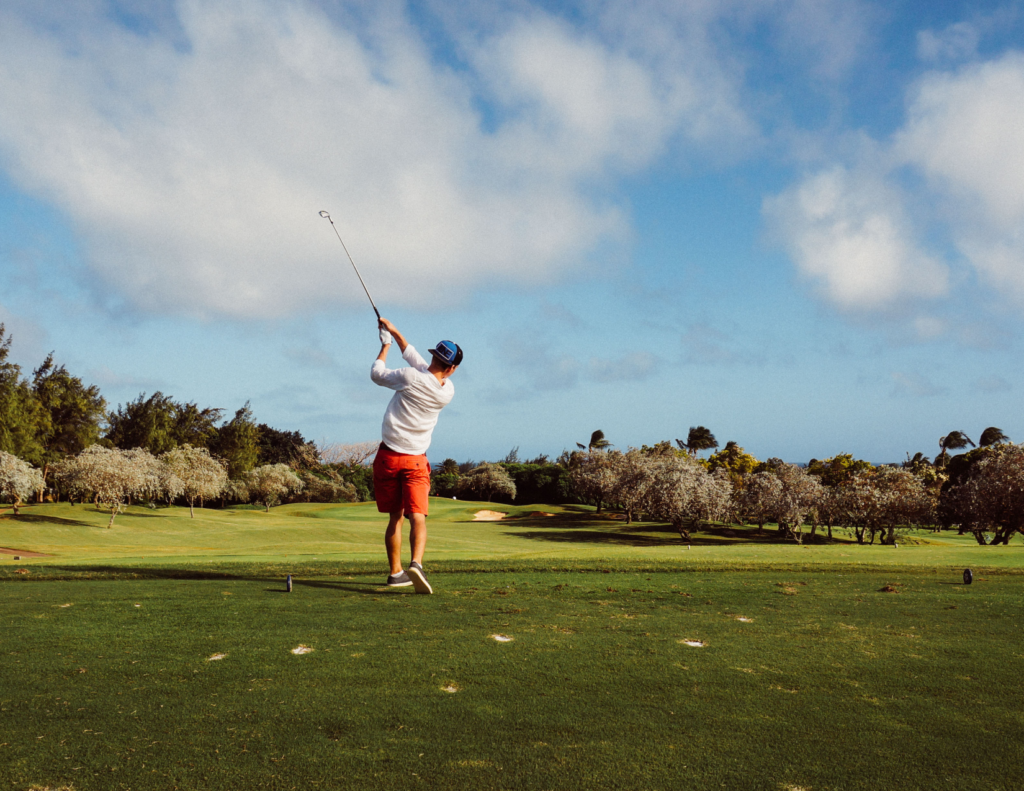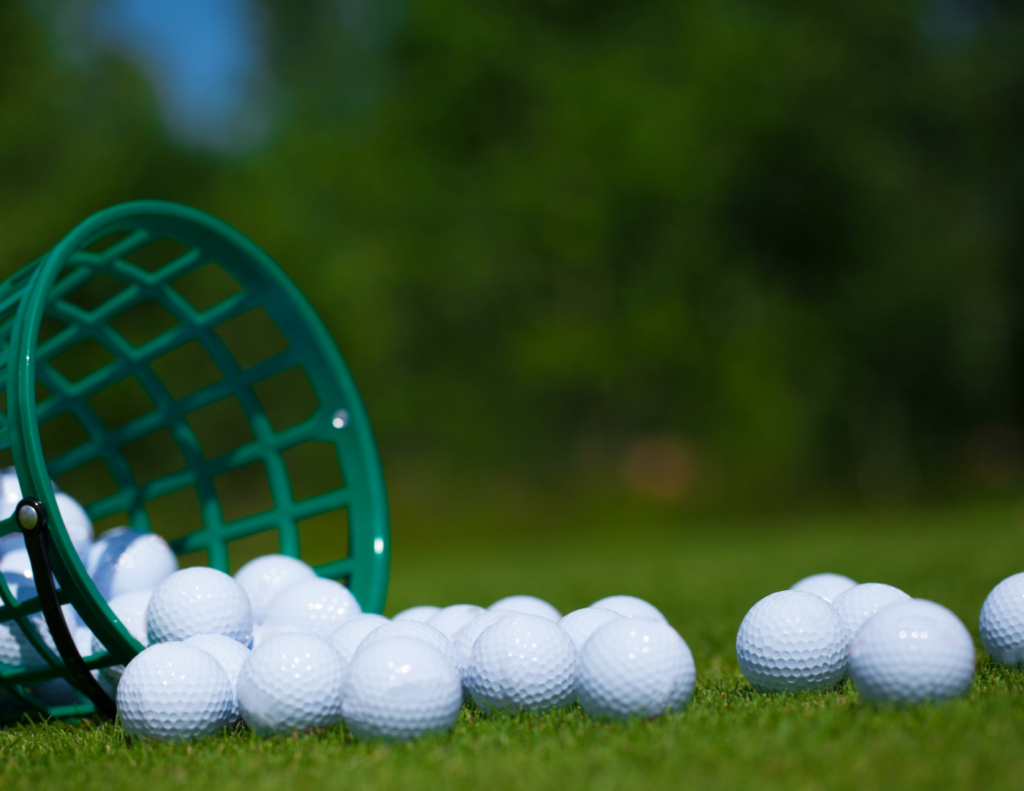Many golfers dream of hitting a draw and fade, while most struggle with fighting a slice or managing their fade.
What if you could hit a draw or a fade on demand? Do you think you could play better golf?
For many amateurs, there is a lack of knowledge of what causes a fade vs a draw.
Our goal today is to help you with the following:
- Understand what causes a ball to fade or draw
- Understand how to execute both shots
- Understand when to play the draw or the fade
- Understand what drills can help you develop the shots you want to hit.
The best golfers are able to hit both and many will slightly curve the ball as a fade or a draw depending on the shape of the hole even if they play a draw or fade 80% or more of the time.

Fade Vs Draw Swing
To understand the fade vs draw swing, we must dive into the ball flight laws. The crazy thing about the ball flight laws below is that they weren’t completely understood until more recently.
For many years, golf instructors had it wrong, leading many golfers down difficult paths. Fortunately, golf instruction has come a long way when the launch monitor and other technology tools revealed what really causes a ball to curve and what swing actions produce these shots.
#1 What Causes A Golf Ball To Fade or Draw
Quite simply it comes down to the ball flight laws. The ball flight laws have these basic rules:
- The ball will start in the general direction of the clubface at impact.
- The ball will curve away from the direction of the swing path.
So let’s jump right into some further clarification.
- If your clubface is open at impact, the ball will start to the right.
- If your clubface is closed at impact, the ball will start to the left.
- If your swing path is right of the clubface, the ball will curve from right to left.
- If your swing path is to the left of the clubface, the ball will curve from left to right.
In order to hit a push draw (shot that starts right and draws back towards the target)
- The golfer will want a clubface that is slightly open with a path that is further right. For example: a club face that is 1-2 degree open and a swing path that is 3-4 degrees to the right.
In order to hit a pull draw (shot that starts left and draws lef)
- The golfer will want a club face that is slightly closed at impact with a path that is slight to the right of the face. For example: a club face that is 1-2 degrees closed with a path that is 1-2 degrees to the right.
In order to hit a push fade (shot that starts right and fades to the right)
- The golfer will want a clubface that is bit more open with a swing path just left of the clubface. For example: a club face that is 3-4 degrees open with a swing path that is 1-2 degrees to the right.
In order to hit a pull fade (shot that starts left and fades to the right)
- The golfer will want a club face that is slightly closed with a path left of the clubface. For example: a clubface that is 1-2 degrees closed with a swing path that is 3-4 degrees to the left.
The great news is that there have been great golfers that have hit each of the four shots above. Many golfers hit the push draw (the first shot above), while there have been plenty that have aimed slightly left and hit a push fade (Lee Trevino, Jack Nicklaus) and those that have hit a pull draw (Arnold Palmer, Sam Snead).
The other great news is that you don’t have to be able to hit all four shots and you can play great golf with even just one shot pattern, which is actually prefered by some greats and some instructors.
Many golfers strive to hit the push draw as it is a great looking shot that starts right and draws back to the target.
One thing to keep in mind is that as the ball starts to curve too much either right or left the main cause is too large of a gap between the clubface and swing path.
When the gap gets too large this is known as the slice or the hook.
Fade shot in golf: complete overview

#2 How To Execute the Fade and Draw Swing
The first order of business for any golfer trying to get better or to hit certain shape shots is to be able to control the clubface at impact. The golfer can practice the following:
- Try hitting some push shots where the ball starts to the right.
- Try hitting some pull shots where the ball starts to the left.
- Try hitting some straight shots where the ball starts right down the target line.
The golfer will need to train his or her hands to control the clubface and the start line. Keep in mind that the start line is impacted by the direction the clubface is pointing at impact.
The 2nd step for the golfer is the following:
- Try to hit a shot that starts to the right and draws back to the middle. If you struggle to get the ball to curve right to left, go ahead and close down your clubface at address and close your strance (these are two extremes), but should set you up to get the ball curving from right to left.
- After some time, reduce both factors above and see if you can slow down the curve a bit to a gentle draw.
- Now do the opposite and try to hit some fade shots. If you struggle to get the ball to curve left to right, go ahead and open the club face and open your stance or swing left to get your path moving across the ball.
- After some time, reduce both factors and see if you can hit a gentle fade shot.
Of course, getting comfortable with both shots will take time, but understand the importance of the relationship between the clubface and swing path and try adjusting both to see what results you can get at the driving range.

#3 When To Play the Draw or Fade
This is a topic that could be debated for a long time. There are those that argue to stick with your stock shot and perfect it, while others will tell you to play the shaped shot that the hole calls for.
If the hole curves left to right, hit the fade.
If the hole curves right to left, hit the draw.
My final conclusion on this is to know your swing for that round. Somedays you might be able to hit both shaped shots and other days you might need to rely and stick with your stock shot. Everyday is a different day at the course, continue to work on both and maybe only hit the opposite shot of your stock shot on the most extreme shaped holes.

#4 Drills to Develop a Draw and Fade
Our go to drill for this is the stock shot drill. You can use this drill below and practice the draw or the fade or even both within the same practice session.
Here is a wonderful drill you can use to build a stock shot:
- At the driving range, set up an alignment stick about 6-8 yards in front of you, straight down your target line.
- If you have a second alignment stick, set the stick 3-4 feet right of the first stick (for a draw) or left of the first stick (for a fade).
- Complete your initial assessment see how many times out of 10 you can start the ball to the right or left of your target. Pick one side and measure your game at this point.
- The goal is to eventually get 7 out of 10 shots to start to the correct side and draw back towards the target.
The next level is to play a golf course in your mind at the driving range. Think of a shot on the course you frequently play and try to execute it as both a draw or fade to see if you can take your drill and practice a game like situation.
BONUS TIP: Utilize A Launch Monitor!
I would highly recommend checking out a golf simulator to get some basic numbers on your golf shots. The key data I like to look at is the spin axis number on my Skytrak Launch Monitor. Both the Skytrak and the Mevo launch monitors are great affordable launch monitors that can be used in a variety of ways from a golf simulator setup, to the driving range or even on the course.
My Secret To Golf Improvement
Let’s face it, in order to get really good at golf, we must practice frequently. About five years ago, I made the leap and invested in a golf simulator build for my garage. I went with a SkyTrak Launch Monitor and the TGC software and can now play over 100,000 courses including Augusta, Pebble Beach, Bethpage Black, Whistling Straits. St. Andrews and many other of the top 100 courses in the world.
This golf simulator setup, which is more affordable that you might imagine, has been a game changer. I can now play golf everyday of the year regardless of rain, snow, cold weather or time of day. I can practice or play rounds of golf. I can stand in the 11th fairway at Augusta and with the auto-rewind feature I am able to practice my approach shots from various differences.
It is worth checking out through Rain or Shine Golf as they offer some incredible packages along with financing offers that are difficult to beat.
Some direct links to Rain or Shine Golf for pricing and financing:
I am an amateur golfer on a journey to get better, enjoy the game as often as possible and share my passion and knowledge with others. I have coached high school golfers at a high level and have a great passion for the game and want to give back. I enjoy learning about the golf swing and am currently studying to be a certified professional golf instructor. Join me in our journey to get better everyday.

